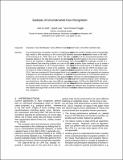| dc.contributor.author | Leibo, Joel Z. | |
| dc.contributor.author | Liao, Qianli | |
| dc.contributor.author | Poggio, Tomaso A. | |
| dc.date.accessioned | 2016-05-13T19:00:14Z | |
| dc.date.available | 2016-05-13T19:00:14Z | |
| dc.date.issued | 2014-01 | |
| dc.identifier.uri | http://hdl.handle.net/1721.1/102486 | |
| dc.description.abstract | Unconstrained face recognition remains a challenging computer vision problem despite recent exceptionally high results ( ~ 95% accuracy) on the current gold standard evaluation dataset: Labeled Faces in the Wild (LFW). We offer a decomposition of the unconstrained problem into subtasks based on the idea that invariance to identity-preserving transformations is the crux of recognition. Each of the subtasks in the Subtasks of Unconstrained Face Recognition (SUFR) challenge consists of a same-different face-matching problem on a set of 400 individual synthetic faces rendered so as to isolate a specific transformation or set of transformations. We characterized the performance of 9 different models (8 previously published) on each of the subtasks. One notable finding was that the HMAX-C2 feature was not nearly as clutter-resistant as had been suggested by previous publications. Next we considered LFW and argued that it is too easy of a task to continue to be regarded as a measure of progress on unconstrained face recognition. In particular, strong performance on LFW requires almost no invariance, yet it cannot be considered a fair approximation of the outcome of a detection --> alignment pipeline since it does not contain the kinds of variability that realistic alignment systems produce when working on non-frontal faces. We offer a new, more difficult, natural image dataset: SUFR-in-the-Wild (SUFR-W), which we created using a protocol that was similar to LFW, but with a few differences designed to produce more need for transformation invariance. We present baseline results for eight different face recognition systems on the new dataset and argue that it is time to retire LFW and move on to more difficult evaluations for unconstrained face recognition. | en_US |
| dc.language.iso | en_US | |
| dc.relation.isversionof | http://www.visapp.visigrapp.org/Abstracts/2014/VISAPP_2014_Abstracts.htm | en_US |
| dc.rights | Creative Commons Attribution-Noncommercial-Share Alike | en_US |
| dc.rights.uri | http://creativecommons.org/licenses/by-nc-sa/4.0/ | en_US |
| dc.source | MIT web domain | en_US |
| dc.title | Subtasks of unconstrained face recognition | en_US |
| dc.type | Article | en_US |
| dc.identifier.citation | Leibo, Joel Z., Qianli Liao, and Tomaso Poggio. "Subtasks of unconstrained face recognition." 2014 9th International Conference on Computer Vision Theory and Applications (VISAPP 2014) (January 2014). | en_US |
| dc.contributor.department | Center for Brains, Minds and Machines at MIT | en_US |
| dc.contributor.department | Massachusetts Institute of Technology. Department of Brain and Cognitive Sciences | en_US |
| dc.contributor.department | Massachusetts Institute of Technology. Department of Electrical Engineering and Computer Science | en_US |
| dc.contributor.department | McGovern Institute for Brain Research at MIT | en_US |
| dc.contributor.mitauthor | Leibo, Joel Z. | en_US |
| dc.contributor.mitauthor | Liao, Qianli | en_US |
| dc.contributor.mitauthor | Poggio, Tomaso A. | en_US |
| dc.relation.journal | Proceedings of the 2014 9th International Conference on Computer Vision Theory and Applications (VISAPP 2014) | en_US |
| dc.eprint.version | Author's final manuscript | en_US |
| dc.type.uri | http://purl.org/eprint/type/ConferencePaper | en_US |
| eprint.status | http://purl.org/eprint/status/NonPeerReviewed | en_US |
| dspace.orderedauthors | Leibo, Joel Z.; Liao, Qianli; Poggio, Tomaso | en_US |
| dspace.embargo.terms | N | en_US |
| dc.identifier.orcid | https://orcid.org/0000-0002-3153-916X | |
| dc.identifier.orcid | https://orcid.org/0000-0002-3944-0455 | |
| dc.identifier.orcid | https://orcid.org/0000-0003-0076-621X | |
| mit.license | OPEN_ACCESS_POLICY | en_US |
